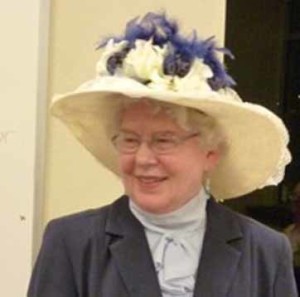 Happy New Year! Relevant History welcomes Karen Wills, who lives near Glacier National Park. She writes historical, often frontier, novels. She’s practiced law, representing plaintiffs in Civil Rights cases. She’s taught English classes at college and secondary public school levels, including on South Dakota’s Cheyenne River Sioux Reservation and in the Inupiaq village of Wales, Alaska. She’s encountered both grizzly and polar bears and still believes we need wild creatures and wilderness. Her novels include the self-published archaeological thriller Remarkable Silence and traditionally published River with No Bridge. All Too Human will be released in 2019. To learn more about her and her books, visit her web site, and follow her on Facebook and Twitter.
Happy New Year! Relevant History welcomes Karen Wills, who lives near Glacier National Park. She writes historical, often frontier, novels. She’s practiced law, representing plaintiffs in Civil Rights cases. She’s taught English classes at college and secondary public school levels, including on South Dakota’s Cheyenne River Sioux Reservation and in the Inupiaq village of Wales, Alaska. She’s encountered both grizzly and polar bears and still believes we need wild creatures and wilderness. Her novels include the self-published archaeological thriller Remarkable Silence and traditionally published River with No Bridge. All Too Human will be released in 2019. To learn more about her and her books, visit her web site, and follow her on Facebook and Twitter.
*****
I fell in love with Glacier National Park as a three-year-old in Glacier Park Lodge, a magnificent alpine structure built by the Great Northern Railway. My family attended the hotel’s evening program featuring Blackfeet tribal members dancing to drums and traditional singing.
The biggest man, wearing full regalia including a feather headdress, stepped out of the circle and beckoned me to join in the dance. Mom nodded. I slipped my hand in his. I still remember our shadows cast against the wall, mysterious silhouettes bending and rising, bending and rising.
The full history of the place that became Glacier National Park is a narrative of loss, discovery, and calculated enticements. The “Indian Wars” lurched to their painful close in the last decades of the 19th century. The romance of the Old West, the freedom of unfenced plains, the hunting of vast buffalo herds, and the culture of the Northern Plains tribes nearly vanished under soul-deadening destruction. Transitioning to reservation life, Blackfeet and others endured starvation, illness, and the forcible removal of their children to boarding schools. The government banned sacred ceremonies such as the Sun Dance.
But while Natives endured hardship, legendary names and images of the lost American West lived on the world over. European children read enthralling stories from James Fenimore Cooper to German author Karl May’s popular Wild West tales. Three of these avid readers, John Fery, Winold Reiss, and Julius Seyler, later journeyed to Montana to paint the mountains, waters, wildlife, and people in and near Glacier National Park.
“See America First”
Louis W. Hill, son of James J. Hill, founder of the Great Northern Railway, lobbied for the establishment of Glacier National Park. In 1910, President Taft signed legislation that made Hill’s dream a reality. Hill loved the Park, hunted and fished in it, and as an amateur artist, painted its mountains. President of the Great Northern, he found ways to promote the ‘Crown Jewel of the Continent’ and attract tourists to the ‘American Alps.’ He built hotels and chalets that combined being rustic with architecture and décor reminiscent of Swiss hotels. He invited Blackfeet from their nearby reservation to meet trains, and set up their lodges, their tepees, on the grounds of Glacier Park Lodge. He also hired and bought the work of artists whose depictions would entice easterners to “See America First.”
Three of Hill’s German and Austrian artists’ serious works as well as the advertising art of two of them are still sought after for color, quality, and collectors’ unending fascination with vanished, unspoiled wilderness. In his book Art Across America, William Gerdts wrote, “Railway stations and hotels served in a real sense as the first ‘art galleries’ in the West, at a time before traditional art institutions were envisioned in the region.”
John Fery
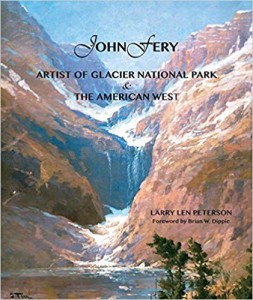 Fery, born Johann Nepomuck Levy in Strasswatchen, Austria, on 25 March 1859, moved to Milwaukee, Wisconsin, in 1883, changing his name to John Fery. An outdoorsman, he frequently left his family in Milwaukee to go west to paint. Hill noticed his work and hired him for the “See America First” campaign. Prolific, Fery created big mountainous scenes for the Great Northern that hung in Glacier National Park hotels, Great Northern depots, and ticket agent offices. Fery produced about fourteen huge landscapes per month.
Fery, born Johann Nepomuck Levy in Strasswatchen, Austria, on 25 March 1859, moved to Milwaukee, Wisconsin, in 1883, changing his name to John Fery. An outdoorsman, he frequently left his family in Milwaukee to go west to paint. Hill noticed his work and hired him for the “See America First” campaign. Prolific, Fery created big mountainous scenes for the Great Northern that hung in Glacier National Park hotels, Great Northern depots, and ticket agent offices. Fery produced about fourteen huge landscapes per month.
Finally, Hill told him to paint his illustration-like works in the St. Paul, Minnesota, studio that the Great Northern provided him. It seemed an interest in portraits of Blackfeet and scenes including them had arisen. Hill wanted artists who could fill the demand. He called the Blackfeet his “Glacier Park Indians.”
Julius Seyler
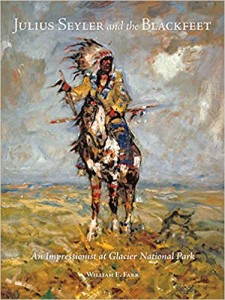 Julius Seyler was born in Munich, Germany, in 1873. He studied art but also became a competitive ice skater. He achieved fame for both his impressionist art and prowess at speed skating before he came to America.
Julius Seyler was born in Munich, Germany, in 1873. He studied art but also became a competitive ice skater. He achieved fame for both his impressionist art and prowess at speed skating before he came to America.
He, too, felt a fascination with the American West, especially the Blackfeet of the Northern Plains. He’d married an American from St. Paul who had a family connection to Louis Hill. The men met and Seyler soon found himself traveling west with Hill in the tycoon’s private rail car, headed toward Glacier Park and the Blackfeet reservation.
Seyler fell under the spell of the Rockies and the Blackfeet. He painted them, struggled to learn all he could about and from them—and the tribe adopted him. While he never worked for the Great Northern, he sold art to the company. Hill’s home in St. Paul had private showings of Seyler’s work, paintings that memorialized the vanished frontier.
Still a German citizen of fighting age when WWI broke out, Seyler fell out of favor with American art buyers including Hill. Unable to return to Germany, Seyler and his wife farmed in Wisconsin until the War’s end, when they returned to Germany.
Winold Reiss
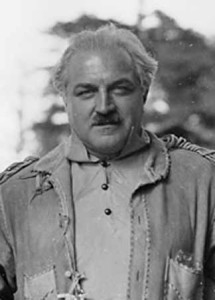 Our third artist, Winold Reiss, was born in Karlsrhuh, Germany, in the Black Forest region, in 1888. He sailed to America in 1913 eager to paint Indians, eventually finding his way to Glacier National Park. While Julius Seyler painted iconic Native American types, Reiss focused in detail on Blackfeet individuals, their features and clothing. His realism appealed to Hill. Reiss’s work, starting in 1933, appeared on calendars and even menus for the Great Northern Railway.
Our third artist, Winold Reiss, was born in Karlsrhuh, Germany, in the Black Forest region, in 1888. He sailed to America in 1913 eager to paint Indians, eventually finding his way to Glacier National Park. While Julius Seyler painted iconic Native American types, Reiss focused in detail on Blackfeet individuals, their features and clothing. His realism appealed to Hill. Reiss’s work, starting in 1933, appeared on calendars and even menus for the Great Northern Railway.
My work in progress, Garden in the Sky, has one character inspired by the German/Austrian artists of Glacier. They and other artists, as William Farr wrote “…chose to make the Old West last as long as they could.” Perhaps that’s what we authors of frontier novels like my River with No Bridge and soon-to-be-released All Too Human attempt as well.
Sources:
o Farr, William E. Julius Seyler and the Blackfeet: An Impressionist at Glacier National Park, Norman: University of Oklahoma Press, 2009.
o Peterson, Larry Len. The Call of the Mountains: The Artists of Glacier National Park. Tucson, Arizona: Settlers West Galleries, 2002.
o Saar, Meghan: Glacier’s Great Artists (https://truewestmagazine.com/author/meghan)
*****
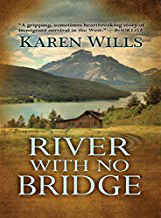 A big thanks to Karen Wills! She’ll give away a hardback copy of River with No Bridge to two people who contribute a comment on my blog this week. I’ll choose the winner from among those who comment by Friday at 6 p.m. ET. Delivery is available in the U.S. only.
A big thanks to Karen Wills! She’ll give away a hardback copy of River with No Bridge to two people who contribute a comment on my blog this week. I’ll choose the winner from among those who comment by Friday at 6 p.m. ET. Delivery is available in the U.S. only.
**********
Did you like what you read? Learn about downloads, discounts, and special offers from Relevant History authors and Suzanne Adair. Subscribe to Suzanne’s free newsletter.
